On the Importance of Nagging the Unvaccinated
Tagged:COVID
/
PharmaAndBiotech
/
Politics
It’s important that we keep nagging people to get vaccinated, at escalating levels of unpleasantness. Let me show you why.
The consequences of choosing to remain unvaccinated
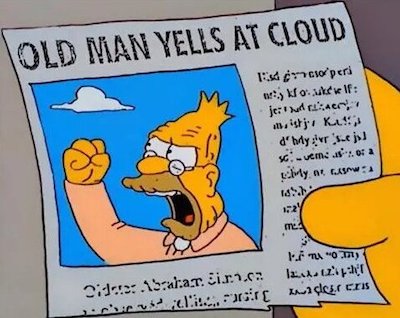 Now, if you’ve seen almost anything on this crummy little blog that nobody reads, you
know what I’m going to tell you: being unvaccinated without excellent reason is a bad
way to live personally, a bad way to treat the people around you, and a bad way to
overload the medical system in your area. But… I might just be an old man yelling
at a cloud, for all you know.
Now, if you’ve seen almost anything on this crummy little blog that nobody reads, you
know what I’m going to tell you: being unvaccinated without excellent reason is a bad
way to live personally, a bad way to treat the people around you, and a bad way to
overload the medical system in your area. But… I might just be an old man yelling
at a cloud, for all you know.
It would be much better if we could find a source of reliable data and trustworthy analysis. Or better yet: the ability to analyze that data for ourselves and draw some statistical conclusions.
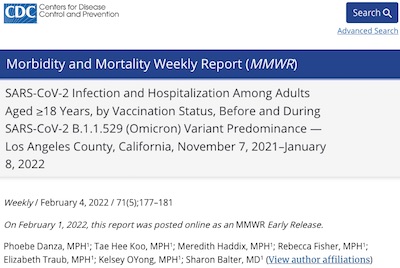 Fortunately, last Friday’s edition of the US CDC’s Morbidity and Mortality Weekly Report
has an article by Danza, et al. [1] that’s just the ticket.
They report a large study conducted by the Los Angeles County Department of Public Health
on COVID-19 patients late last year, properly age-adjusted to avoid any whiff of
Simpson’s Paradox. (Note that the report doesn’t
specify in detail how they did the age adjustment, so we can’t quite check. But they’re
competent statisticians who said the magic words, so I’m inclined to trust them. If they
screwed up, they’ll get caught and we’ll figure it out if that happens. For now: benefit
of doubt given.)
Fortunately, last Friday’s edition of the US CDC’s Morbidity and Mortality Weekly Report
has an article by Danza, et al. [1] that’s just the ticket.
They report a large study conducted by the Los Angeles County Department of Public Health
on COVID-19 patients late last year, properly age-adjusted to avoid any whiff of
Simpson’s Paradox. (Note that the report doesn’t
specify in detail how they did the age adjustment, so we can’t quite check. But they’re
competent statisticians who said the magic words, so I’m inclined to trust them. If they
screwed up, they’ll get caught and we’ll figure it out if that happens. For now: benefit
of doubt given.)
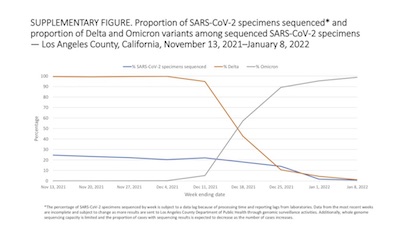 First, in Supplementary Figure 1 shown here (click to embiggen), we see the period covered
started out with 100% Delta patients and ended with 100% Omicron patients. During
the crossover period, they estimate they sequenced about 20% of all COVID-19 patients in
their area. This is a dramatic graphical portrayal of just how much more infectious
Omicron is over Delta.
First, in Supplementary Figure 1 shown here (click to embiggen), we see the period covered
started out with 100% Delta patients and ended with 100% Omicron patients. During
the crossover period, they estimate they sequenced about 20% of all COVID-19 patients in
their area. This is a dramatic graphical portrayal of just how much more infectious
Omicron is over Delta.
Conclusion: Delta was bad; Omicron is worse. If you’re not vaccinated and boosted, you will get Omicron and it will be bad. (If you’re vaccinated and boosted, you still might get Omicron, but it probably will be annoying, not awful.)
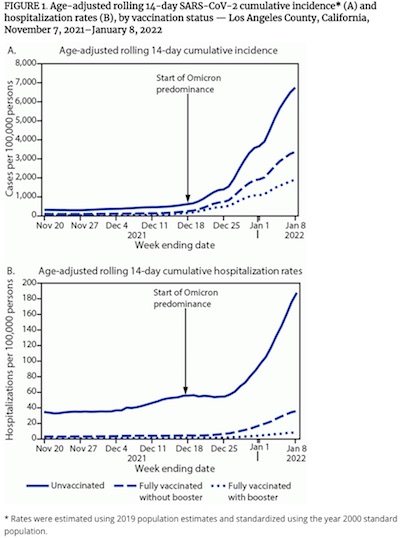 Next, have a look at their Figures 1 A&B, reproduced here (click to embiggen).
Next, have a look at their Figures 1 A&B, reproduced here (click to embiggen).
- The top figure shows the time course of cases per 100,000 population. It’s properly age-adjusted, and broken down by vaccination status. The solid line is for the unvaccinated, and the dashed line is for the vaccinated and boosted. Note that while all lines are rising, the unvaccinated are rising dramatically fast while the vaccinated and boosted are getting just a few infections.
- The bottom figure is the same sort of thing, but for hospitlizations per 100,000. Note the even stronger effect: the unvaccinated are headed for disaster and clogged hospitals, while the vaccinated and boosted barely notice.
Conclusion: Being unvaccinated is a terrible strategic error: it subjects you to infection at higher rates, and make you impose a burden on hospitals at a fantastically higher rate. That then blocks other people who need those hospital resourcese for more mundane purposes like broken legs, heart attacks, and cancer. Don’t be the dog in the manger here: get vaccinated so you don’t block up an important resource.
Even more interestingly, if you’re a statistics nerd, is that they could calculate risk ratios between unvaccinated vs vaccinated + boosted populations. That amounts to calculating ratios of conditional probabilities for infection and hospitalization like:
{RRinfect=PrLet’s see what they found for risk ratios in the Delta and Omicron wave:
| Delta | Omicron | |||
|---|---|---|---|---|
| Infection | 12.3 | 3.8 | ||
| Hospitalization | 83.0 | 12.9 |
(Now, I didn’t dig deep enough to see if they provided enough information to check the risk ratio calculation, let alone enough to get a 95% confidence interval on them. I’m a little ripped that they didn’t report the confidence interval, but let’s go ahead and take them at their word here.)
Conclusion: If you are unvaccinated, you are at massively higher risk – as in orders of magnitude higher – compared to vaccinated and boosted people. Why in the world would you have tolerated more than 80 times the risk of hospitalization during Delta? Why would you continue to tolerate more than 10 times the risk now during Omicron? (Answer: you should not tolerate it, and should get vaccinated and then boosted.)
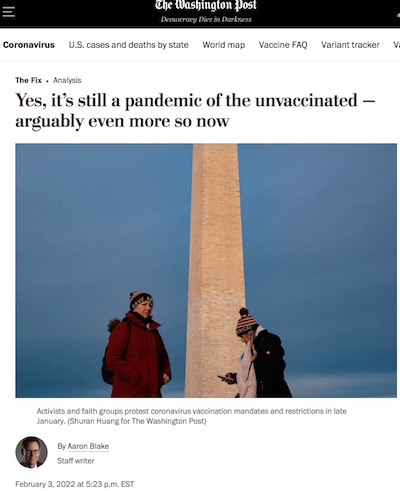 Look: the pandemic would be over now if people would stop refusing the vaccine for
stupidly superstitious reasons. (And, admittedly, if the developed nations would cease
their sociopathic self-regard long enough to recognize even their self-interest in
vaccinating the rest of humanity, particularly in the developing nations.)
Look: the pandemic would be over now if people would stop refusing the vaccine for
stupidly superstitious reasons. (And, admittedly, if the developed nations would cease
their sociopathic self-regard long enough to recognize even their self-interest in
vaccinating the rest of humanity, particularly in the developing nations.)
This really is, still, a “pandemic of the unvaccinated”, as Aaron Blake writes in the Washington Post [2], inspired by the MMWR report above. I just don’t understand Republican wooden-headedness on this subject (and, to be fair, on many other subjects). He notes other studies in other jurisdictions (it’s not just an LA thing!) finding similar results, with double-digit risk ratios for the unvaccinated – that’s just stupid large!
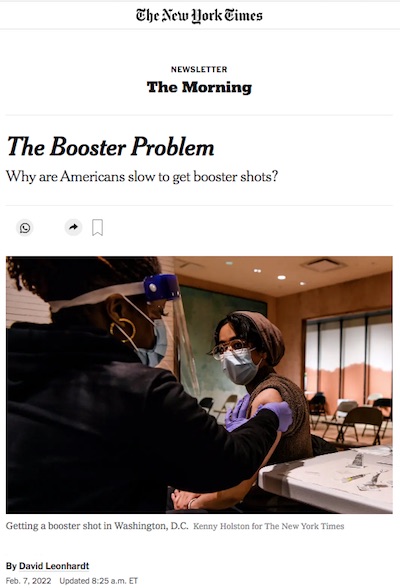
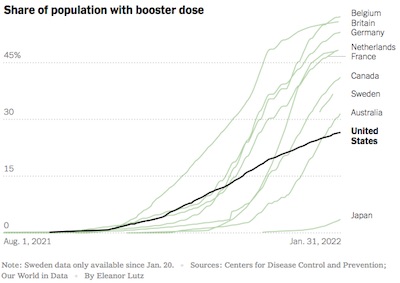
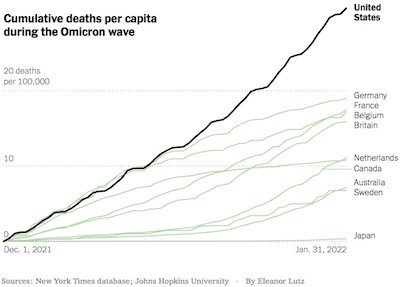
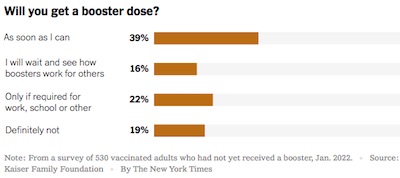 Even if we write off those who resist vaccination as hopeless cases deteremined to die of
COVID-19, why won’t the rest of us get boosters in larger numbers? This is a question
asked by David Leonhardt in the New York Times yesterday. [3]
Even if we write off those who resist vaccination as hopeless cases deteremined to die of
COVID-19, why won’t the rest of us get boosters in larger numbers? This is a question
asked by David Leonhardt in the New York Times yesterday. [3]
He points out 2 very painful facts, shown here graphically from his article:
- The rate of booster uptake per capita in the US is lower than in other developed nations (black line), and
- The cumulative deaths per capita in the US are, correspondingly, dramatically higher (black line).
Somehow, Americans are resisting boosters strongly enough that they are willing to die for that belief. What could it possibly be?
Leonhardt proposes 2 features of the sadistic American healthcare system are at fault here:
- Extreme fragmentation: We just can’t get our act together with centralized medical reporting, or even the ability to remind people to get a booster. That’s up to literally thousands and thousands of HMOs, hospitals, and individual practicese. Startlingly, most Americans do not have a regular point of contact about healthcare. In this situation, that’s lethal.
- Government communication: It’s been terrible. Leonhardt notes that they speak in the “language of academia”, with abundant cautions and notes for exceptions. Now here at Chez Weekend we speak the “language of academia” like natives, so that’s ok by us. But most people do not: they hear something complicated and decide to ignore it; they hear caveats and decide it’s dangerous; they hear exceptions and decide it doesn’t work. For example, many are still somehow confused on the subject of whether masks work! Some are even confused as to whether vaccines work, when they are probably one of the most stupendously successful vaccines in human history (and we somehow manage not to say that). Now to be fair, this is just a combination of stupidity and the massive failure of the American educational system; but it’s also the reality with which we must engage.
We were slow to grant full approval to the vaccines: Pfizer not until 2021-Aug-23 and Moderna not until 2022-Jan-31. We were slow to approve rapid tests at home, and then made people work through insurance paperwork to pay for them. We were slow to work out that the J&J vaccine recpients probably also needed a booster.
We were slow with all that… and now we’re slow getting boosters. We’re not slow to die, though.
Why we’re making this harder than it has to be
It still bugs me, though, as an American: why are we so insistently making this much much harder than it has to be?
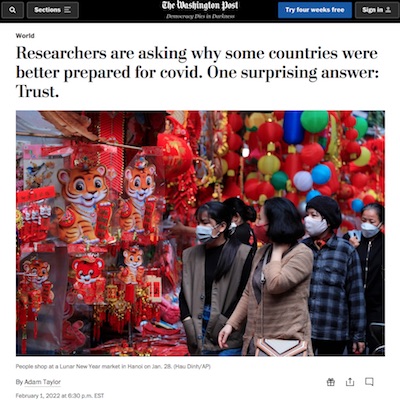
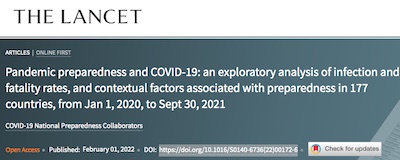
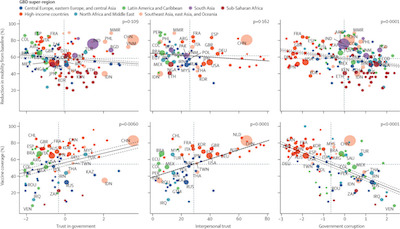 That’s the subject of an article by Adam Taylor in the
Washington Post [4], summarizing a research article
in The Lancet by the COVID-19 National Preparedness Collaborators. [5]
That’s the subject of an article by Adam Taylor in the
Washington Post [4], summarizing a research article
in The Lancet by the COVID-19 National Preparedness Collaborators. [5]
Taylor starts with the example of Vietnam: a smallish country that looked pretty vulnerable to pandemics. But… they’ve performed fantastically: good public health measures to keep infection rates low, good vaccine uptake, and as a result low fatalities compared to much richer countries. One might, very reasonably, ask why that was the case and what the rest of us could learn from it. That study, of 177 countries, was the subject of the Lancet article.
Now, the article wrestles with a lot of potential predictors. But in a way that is both surprising to me and simultaneously sickeningly unsurprising, one big element was trust in government and perception that the government is not corrupt. Have a look at their Figure 4, shown here (click to embiggen):
- The top row of 3 plots is about population mobility, so ignore that.
- The bottom row of 3 plots shows vaccine coverage (a measure of sensible pandemic response) plotted against measures of trust in government, interpersonal trust, and government corruption.
The inescapable conclusion is related to trust:
- A people who trust their government to tell them the truth,
- Trust each other, and
- Perceive their government as not corrupt
… will respond sensibly and get vaccinated.
In the words of Thomas Bollyky, one of the study authors, to the WaPo:
We found no links between covid outcomes and democracy, populism, government effectiveness, universal health care, pandemic preparedness metrics, economic inequality or trust in science.
He estimated that if all countries trusted their governments as much as Denmark (and if their governments had been as trustworthy as Denmark’s), then 13% of world COVID-19 deaths could have been avoided. Increased level of trust in others could have lowered infections by as much as 40%.
Now, in the US we had the 2nd worst standardized infection rate among infected countries. After 2 generations of degrading trust in government since Reagan in the 1980s, we show social wounds in all 3 of those areas. Republicans in particular hammer their points that the government is not to be trusted; each person is only responsible for themselves as individuals, with no collective obligations; and provided us with Trump as an example of the most corrupt administration in US history. So each of the factors above has been systematically degraded by 2 generations of right-wing political and economic poison.
How did we lose trust, and keep it from growing back?
Basically, we’ve allowed economic inequality to approach and exceed the levels of the Gilded Age, now approaching the Middle Ages with aristocrats and peasants. That means the rich and powerful are very rich, and very powerful. They’re perfectly capable of reshaping the world to suit their own ends.

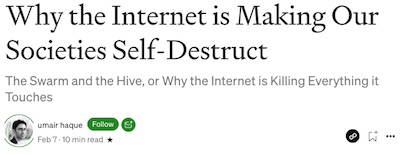 That is essentially the tack taken by Umair Haque, a blogger for whom I have great
respect.
That is essentially the tack taken by Umair Haque, a blogger for whom I have great
respect.
He’s analyzed the recent teapot-tempest of the execrably racist, misogynist, and proto-fascist rantings of Joe Rogan on Spotify [6] and the general use of the Internet to make swarm attacks. [7]
There are some interesting facts to contemplate:
- While it’s true Rogan has about 11 million regular listeners, it’s the same 11 million for each podcast. It’s not like he’s growing much.
- Spotify paid him about $100 million to host his podcasts.
- So they’re paying about $10 for each pair of ears listening. That’s a massive payout for Rogan, and an enormous amount to pay to get listeners.
- Other artists have dramatically larger audiences, for which they are paid a pittance:
- Euro football championship: 5 billion viewers
- The Olympics: 4 billion viewers
- Adele’s “30” album: 30 million streams in one month
- Dua Lipa’s “Levitating”: more than 500 million streams
- Olivia Rodrigo’s top 2 songs: more than 1 billion.
So it seems, on the surface, like a particularly stupid business decision for Spotify to host Rogan at ruinous expense both in terms of money and public disapproval. They’re subsidizing someone to spew hatred, racism, misogyny, ignorance, and COVID-19 disinformation (like ivermectin).
We understand (though we do not respect) why Rogan wants to do it: he’s being paid well. As for his corporate masters? They’re spreading right-wing memes to undermine any sort of effective government that might move toward things people want, like universal healthcare, affordable housing, peaceful foreign policies, green and sustainable energy, and so on. It pays better for the billionaire clade to keep the rest of us under their boot heel.
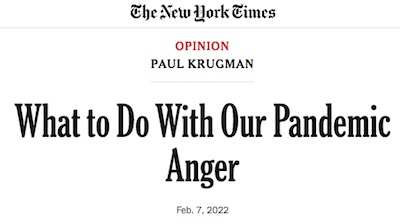 Paul Krugman, the econ Nobelist who moonlights writing at the New York Times, says much
the same, though in more polite terms. [8]
Paul Krugman, the econ Nobelist who moonlights writing at the New York Times, says much
the same, though in more polite terms. [8]
He points out that our wounds are largely self-inflicted: too many of us refuse to break our sociopathic self-regard to act responsibly. “Act responsibly” here is pretty easy to understand: get vaccinated & boosted, wear a mask, do social distancing, use tests.
The rest of us are angry about this. If you’re a vaccine resister, I’m angry at you. You are hurting me, my family, my country, and my world. After 900,000 dead in the US, you should be in no way surprised to hear this.
Like Krugman, I’m tired of the way we bend over backward to accomodate the vaccine refuseniks and the conspiracy whackos. Time to make them bend over backward, instead.
The Weekend Conclusion
We’ll leave the last word to Cheryl Rofer, another retired physics & chemistry type. She specialized in nuclear stuff and national security, so she knows a thing or two about response to threats. And, alas, the public’s myopic and attention-span-impaired attitude:
… back to dying needlessly.
We should learn, so we can live and not die.
Notes & References
1: P Danza, et al., “SARS-CoV-2 Infection and Hospitalization Among Adults Aged ≥18 Years, by Vaccination Status, Before and During SARS-CoV-2 B.1.1.529 (Omicron) Variant Predominance — Los Angeles County, California, November 7, 2021–January 8, 2022”, US Centers for Disease Control & Prevention Morbidity and Mortality Weekly Report, 71:5, 177-181, 2022-Feb-04.
The MMWR is sort of the CDC’s in-house almost-journal for publishing public health data vignettes and analyses. “Morbidity & Mortality” is quite a catchy journal name, no? ↩
2: A Blake, “Yes, it’s still a pandemic of the unvaccinated — arguably even more so now”, Washington Post, 2022-Feb-03. ↩
3: D Leonhardt, “The Booster Problem: Why are Americans slow to get booster shots?”, New York Times, 2022-Feb-07. ↩
4: A Taylor, “Researchers are asking why some countries were better prepared for covid. One surprising answer: Trust.”, Washington Post, 2022-Feb-01. ↩
5: COVID-19 National Preparedness Collaborators, “Pandemic preparedness and COVID-19: an exploratory analysis of infection and fatality rates, and contextual factors associated with preparedness in 177 countries, from Jan 1, 2020, to Sept 30, 2021”, The Lancet, 2022-Feb-01. DOI: 10.1016/S0140-6736(22)00172-6. ↩
6: U Haque, “How the Internet Became a Maelstrom of Hate”, Eudaimonia & Co blog, 2022-Feb-05. ↩
7: U Haque, “Why the Internet is Making Our Societies Self-Destruct”, Eudaimonia & Co blog, 2022-Feb-07. ↩
8: P Krugman, “What to Do With Our Pandemic Anger”, New York Times, 2022-Feb-07. ↩

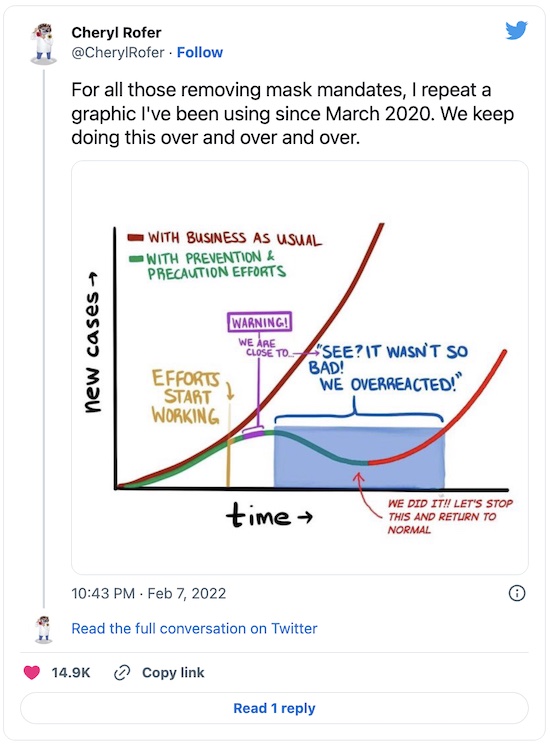
Gestae Commentaria
Comments for this post are closed pending repair of the comment system, but the Email/Twitter/Mastodon icons at page-top always work.